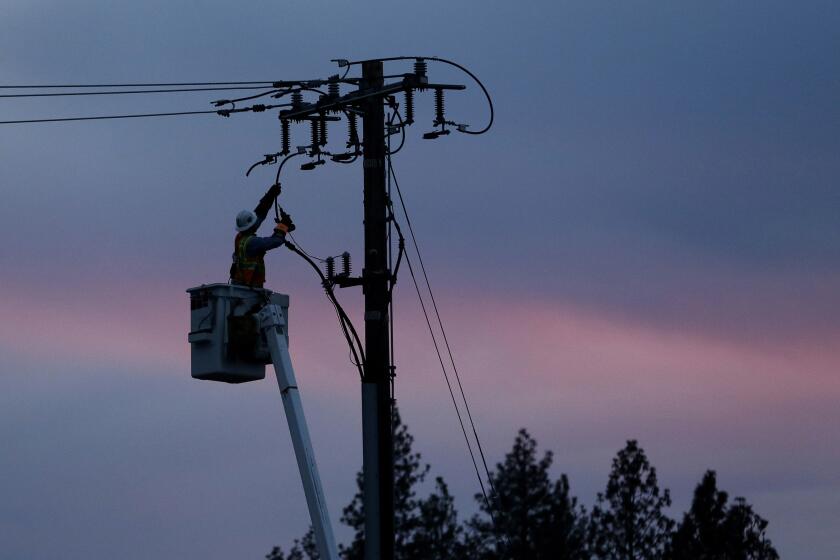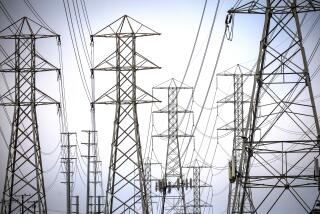
- Share via
- In the last 12 months, California has curtailed production of enough solar energy to power 518,000 homes for a year.
- Californians, whose electric rates are roughly twice the national average, are essentially paying for power capacity they are unable to use.
- The solar glut raises questions about the state’s plan to generate all its electricity from carbon-free sources by 2045.
California is making so much solar energy that large commercial operators are increasingly forced to stop production, raising questions about the state’s costly plan to shift entirely to carbon-free sources of electricity.
In the last 12 months, California’s solar farms have curtailed production of more than 3 million megawatt hours of solar energy, either on the orders of the state’s grid operator or because prices had plummeted because of the glut, according to an analysis of data by The Times.
That’s enough to power 518,000 California homes for a year, based on average electricity usage.
The amount of curtailed solar power has more than doubled from 1.5 million megawatt hours in 2021, state records show, and is up eight times from levels in 2017.
The waste would have been even larger if California had not paid utilities in other states to take the excess solar energy, documents from the state’s grid operator show. That means green energy paid for by California electricity customers is sent away, lowering bills for residents of other states.
Arizona’s largest public utility reaped $69 million in savings last year by buying from the market California created to get rid of its excess solar power. The utility returned that money to its customers as a credit on their bills.
Also reaping profits are electricity traders, including banks and hedge funds.
The increasing oversupply of solar power has created a situation where energy traders can buy the excess at prices so low they become negative, said energy consultant Gary Ackerman, the former executive director of the Western Power Trading Forum. That means the solar plant is paying the traders to take it.
“This is all being underwritten by California ratepayers,” Ackerman said.
California grid officials warned in 2017 that the curtailments were a sign that the state was overbuilding renewables and “not financially sound.”
Since then the problem has grown exponentially. Once the state curtailed solar power only on sunny mild spring days when there was little need for air conditioning. Now solar farms must be shut down even on hot summer days when demand is high.
A solar energy company will soon begin clearing thousands of protected Joshua trees in the Mojave Desert, including many thought to be a century old.
Solar is the linchpin of California’s plan to generate all its electricity from carbon-free sources by 2045, but some energy experts question the feasibility of the plan given the state’s inability to use its existing solar capacity.
On some days, more than half the available solar power goes to waste, said Phillippe Phanivong of the California Institute for Energy and Environment located at UC Berkeley.
He calculates that the amount of power curtailed increased by 500% between 2017 and 2022 — a rise he called “alarming.” During that same time, the state’s renewable energy generation increased by 40%.
“Can we even get to 100% renewable energy with this growth rate of curtailment?” Phanivong asked.
The solar glut also means higher electricity bills for Californians, since they are effectively paying to generate the power but not using it.
California’s electric rates are roughly twice the nation’s average, with only Hawaii having higher rates. Rates at Southern California Edison and Pacific Gas & Electric increased by 51% over the last three years.
“Ratepayers aren’t getting the energy they’ve paid for,” said Ron Miller, an energy industry consultant in Denver. He calculates that the retail value of the solar energy thrown away in a year would be more than $1 billion.
With little public debate, state lawmakers passed a complex energy bill that upended how most Californians are billed for electricity.
Gov. Gavin Newsom’s advisors and those who manage the state’s electric grid say they are working to reduce the curtailments, including by building more industrial-scale battery storage facilities that soak up the excess solar power during the day and then release it at night.
Officials in the governor’s office declined to be interviewed, but issued a statement saying the curtailments are often because of congestion on transmission lines, rather than a statewide oversupply of power. The state has been spending heavily to upgrade transmission lines to ease the congestion.
“It’s also important to have extra energy resources available that can help the state during periods of extreme weather and historic heatwaves when demand is particularly high, which have happened the past few years,” the statement said.

The solar energy glut was one reason the California Public Utilities Commission, whose members are appointed by the governor, voted in late 2022 to slash financial incentives for residential rooftop solar panels.
Homes with rooftop solar have increased the curtailments at the industrial solar farms by decreasing electric demand, said Guillermo Bautista-Alderete, an official with the California Independent System Operator, which runs the state’s power grid.
Grid operators must match the amount of power being produced to demand to prevent the grid from overloading, he said.
Bautista-Alderete said the state has been able to reduce the amount of curtailed power by creating a broader market where power can be sent to other states. Because other states may not need the power, California often has to pay them to take it, he said.
Asked how much the state has paid utilities in other states to take the excess solar, he said, “We don’t track that number specifically.”
Reports from the grid operator, which is also known as CAISO, provide hints of which out-of-state utilities have benefited.
In 2022, the Public Service Company of New Mexico paid an average of $14 less per megawatt hour when California’s grid became clogged with solar, according to a CAISO report. That year, the New Mexico utility said it saved $34 million by participating in the market California created to get rid of its excess power.
Other utilities that benefited in 2022 from reduced prices, according to the report, were PacifiCorp and the Bonneville Power Administration, which both have headquarters in Portland, Ore., as well as Avista Corp., based in Spokane, Wash., and Tacoma Power.
CAISO, a nonprofit company, is overseen by a board nominated by the governor and confirmed by the state Senate.
Mojave town protests solar energy project as crews chainsaw hundreds of protected Joshua trees
The commercial solar industry contends that the expansion of storage capacity to bank solar power will eventually eliminate the glut.
“Successfully increasing storage and solar together will reduce our reliance on natural gas power plants, helping to meet California’s clean energy goals,” said Shannon Eddy, executive director of the Large-Scale Solar Assn., a trade group.
Eddy acknowledged that curtailments deprive Californians of cheap energy.
“Other states do benefit, which helps reduce carbon emissions more regionally,” she said.
Some experts are skeptical that battery storage capacity can be expanded quickly enough to eliminate the glut.
Most industrial-sized batteries can store power for just four hours, not long enough to last through the night. And when batteries are added to solar facilities, the cost is twice as expensive as solar alone, said Andrew Chien, a computer science professor at the University of Chicago.
“They tried all these things, there are all these programs in place, yet curtailment continues to increase,” said Chien, who has led studies of the curtailments, including one published in January.
Economics upended
California already produces more solar than any other state. Newsom administration officials say the state must triple the rate of the construction of industrial-scale solar installations over the next two decades to get to a carbon-free electrical grid by 2045.
To create incentives for companies to build that much solar power, a 2018 law known as Senate Bill 100 requires utilities and locally run electricity providers to purchase an increasing amount of renewable energy, which then becomes part of the electrical mix delivered to customers.
By 2030, 60% of the state’s electricity must be from renewable sources.

The state’s utilities buy most of that energy in advance at a fixed price set by long-term contracts negotiated with the solar farms and other renewable energy producers.
Eddy at the solar association said these contracts protect ratepayers from price hikes during times of high demand. But the contracts can also require electric customers to pay the fixed prices even if they must stop producing because the state has too much electricity.
The Los Angeles Department of Water and Power says that many of its contracts contain such terms.
“Curtailed energy is energy that has already been paid for but cannot be used,” LADWP explained in its 2022 strategic plan, which emphasized it was trying to minimize the curtailments.
To stop the solar farms from sending energy to the grid, CAISO sometimes calls the operator and orders it to shut down, Bautista-Alderete said.
More frequently, however, the software that operates CAISO’s electricity market automatically sends prices plummeting when too much energy is flowing onto the grid, he said. The operator then decides to shut down to avoid losing money.
In the last two years, experts say, a strange thing has happened. When prices fall to $0 on the market, the solar farms keep producing. Some keep generating even when prices plummet to deeply negative prices, where they then have to pay heavily to put their power on the grid.
Ackerman said energy producers are willing to pay to put their power on the grid because they are making money elsewhere.
Among solar farms’ revenues are federal tax credits. Miller, the energy industry consultant, estimated that federal taxpayers paid $54 million to subsidize the 2.6 million megawatt hours that California curtailed in the 12 months ending in October 2023.
An even bigger source of revenue for solar farms is the so-called renewable energy credit, or REC, Ackerman and others say.
Producers of renewable energy get one REC for each megawatt hour they put on the grid. Companies buy the RECs, allowing them to take credit for the environmental benefits of that megawatt hour of solar. A utility or an airline can buy the RECs and then say it burned less fossil fuels than it actually consumed, a practice some criticize as greenwashing.
As California and other states have required utilities to buy more renewable power, demand for the RECs has skyrocketed. So has their price, from $15 to $75 a megawatt-hour in the last two years, experts say.
“All of a sudden there was a huge demand” for the credits, Ackerman said.
That means a solar farm can still earn a profit even when prices are deeply negative. Last year, prices plunged to negative $145 per megawatt-hour or below as the sun was shining, CAISO said in a recent report.
Then the sun sets. And power prices can spike to $50, $100 or far more.
This volatility is a gold mine for electricity traders.
“Any fluctuation, any variation, they’re making money off that,” Chien said.
Traders see profit
Scores of traders buy and sell electricity on the wholesale market that CAISO runs.
Many of the traders work for utilities trying to buy power at the lowest price possible. But some, including banks like Citigroup and hedge funds like Citadel, are not distributing power. They are in the market to make money.
“These profits are losses to ratepayers,” CAISO officials warned about traders trying to collect money from grid congestion in their most recent annual report.
Consulting firms help the traders by closely tracking data on curtailments, weather and congestion on the grid. They calculate when prices are expected to fall and then surge.
“Power traders need to make a living — which means it doesn’t make sense for them to move power from one market to another if prices are the same,” explained Jake Landis at Yes Energy, a consulting firm tracking California’s market, in a blog post.
One popular strategy is to buy power during the day when prices are low or even negative and then sell it as the sun sets and prices soar as solar panels stop producing.
The traders also include those working for utilities in other states, including Arizona Public Service, which operates a 24-hour trading floor in Phoenix looking for California’s cheap or negatively priced solar power.
Solar field construction expanding
California grid officials say that paying other states’ utilities to take the excess solar power is a benefit to the environment since it can replace electricity that would otherwise be produced by fossil fuels.
But sometimes, Arizona Public Service turns off its own solar fields to take California’s excess.
“We may make adjustments to our generation to purchase power … at prices that are economically beneficial to customers,” said Yessica Del Rincon, a spokesperson for the Arizona utility.
In a 2021 report, the Newsom administration estimated California needs another 70 gigawatts of industrial solar farms by 2045 to get to a carbon-free electrical grid. That would require solar to be built across another 300 to 450 square miles, an area that would cover nearly half of Rhode Island.
Some of those projects have cleared thousands of acres of pristine land in the Mojave Desert, where it has angered local residents worried about declining property values and environmentalists concerned about the loss of wildlife habitat.
“We have this planet to save and they are throwing away power?” said Mark Carrington, a resident of Desert Center, a town east of Joshua Tree National Park, which has been nearly surrounded by solar projects. “That can upset people.”
Sean Greene, assistant data and graphics editor, contributed to this report.
More to Read
Sign up for This Evening's Big Stories
Catch up on the day with the 7 biggest L.A. Times stories in your inbox every weekday evening.
You may occasionally receive promotional content from the Los Angeles Times.










